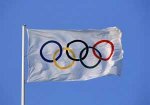The Opening Ceremony
by Karen
Teams parade in alphabetical order, according to the language of the host country, except for Greece, which always comes first. They march round the stadium with their flags and then line up in the middle. The sovereign or head of state declares the Games OPEN! The Olympic Flag is raised to the sound of the Olympic Hymn. Then an athlete reads the Athletes' Oath
"In the name of all competitors, I promise that we shall take part in these Olympic Games, respecting and abiding by the rules that govern them, in the true spirit of sportmanship, for the glory of sport and the honour of our teams."
The anthem of the host country is played and the teams file out of the stadium.

Sonia O'Sullivan carried the flag for Ireland at the Sydney Games in 2000







